Note: This publication is currently undergoing major revisions. The current publication will be replaced with a new publication based on stakeholder requirements and scientific advances. We expect to begin sharing details on this soon. If you have input on content, format, or publication frequency at any time, please contact us at cbrfc.webmasters@noaa.gov.Upper Colorado Water Supply Outlook, May 1, 2011Upper Colorado Water Supply Outlook, May 1, 2011
Contents
Upper Colorado Summary
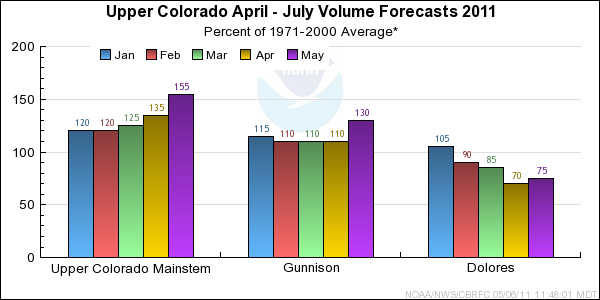
*Median of forecasts within each basin.
Upper Colorado Mainstem Basin Conditions
Many of these forecast volumes are in the top three of historical volumes, with the
forecasts for Lake Granby, Willow Creek Reservoir and Wolford Reservoir at or above
the record volumes.
The following conditions influenced this month's forecasts:
Precipitation:
April
precipitation was near 175 percent of
average overall in the Upper Colorado mainstem basin. However, the uppermost
headwaters of the basin received near 190% of average precipitation for the
month, while the Eagle River basin had close to 230% of average.
Seasonal
precipitation (the total since October) increased
since last month and now stands at 140 percent of average.
Snow:
May 1st snow water equivalent was near 155 percent of average in the basin
as a whole. This is especially significant for this time of year as the snow
melt has been delayed and so it is also near 150% of the average seasonal peak.
Conditions are even more extreme in the headwaters of the basin where the
May 1st snow water equivalent was near 175 percent of average.
Many snotel sites throughout the basin have snow water equivalent values that
are at record levels when compared to their historical period (20-30 years).
--- Upper Colorado basin
snow
water equivalent plot
Streamflow:
April streamflow was above average at 125 percent.
Soil Moisture:
Modeled
soil
moisture states were near to above average heading into the winter.
Climate Forecasts:
Climate forecasts were not a factor because there is not a strong correlation
between La Nina conditions and winter precipitation in the Upper Colorado mainstem basin.
Forecast Summary:
All forecast volumes were raised significantly from last month due to the
much above average precipitation during April as well as cool temperatures which have
delayed the start of the snow melt. This has resulted in near to above record snow pack
conditions throughout much of the basin. Current April through July streamflow volume
forecasts range between 140 and 190 percent of average with a median
value of 155 percent. Current May through July streamflow volume forecasts range
between 145 and 200 percent of average with a median value of 165 percent.
Many of these forecast volumes are in the top three of historical volumes, with the
forecasts for Lake Granby, Willow Creek Reservoir and Wolford Reservoir at or above
the record volumes.
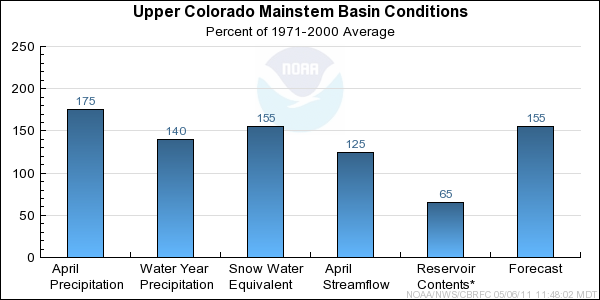
* Percent usable capacity, not percent average contents.
Click for multi-month Graph.
Gunnison Basin Conditions
The following conditions influenced this month's forecasts:
Precipitation:
Seasonal October through April
precipitation was 120 percent of average
in the Gunnison basin. April
precipitation was 150 percent of average.
Snow:
May 1st snow water equivalent was near 140 percent of average in the Gunnison basin; this is around 120% of the seasonal peak.
--- Gunnison basin
snow
water equivalent plot
Streamflow:
April streamflow was 100 percent of average.
Soil Moisture:
Modeled
soil
moisture states were below to near average heading into the winter.
Climate Forecasts:
Climate forecasts were not a factor because there is not a strong correlation
between La Nina conditions and winter precipitation in the Gunnison basin.
Forecast Summary:
April precipitation throughout the Gunnison basin was much above average at 150%. Seasonal precipitation for the Gunnison basin rose from last month to
120% of average.
May 1st snow water equivalent for the Gunnison was much above average with 140%; whereas the snow water equivalent is 120% of the average seasonal peak.
Since there was an increase in the snow water equivalent in the Gunnison basin, the current April through July streamflow
volume forecasts rose from last month's forecast. Current April through July streamflow volume
forecasts range
between 98 and 146 percent of average with a median value of 130 percent.

* Percent usable capacity, not percent average contents.
Click for multi-month Graph.
Dolores Basin Conditions
The following conditions influenced this month's forecasts:
Precipitation:
Seasonal October through April
precipitation was 105 percent of average
in the entire Dolores basin. April
precipitation was 150 percent of average.
Snow:
May 1st snow water equivalent was 95 percent of average in the Dolores basin as a whole; this is about 45% of the seasonal peak.
--- Dolores basin
snow
water equivalent plot
Streamflow:
April streamflow was 65 percent of average.
Soil Moisture:
Modeled
soil
moisture states were average to slightly below average heading into the winter.
Climate Forecasts:
The correlation of La Nina and April through July water volumes in the Dolores basin is small that
it did not influence the forecast process.
Forecast Summary:
April precipitation throughout the Dolores basin was much above average at 150%. Seasonal precipitation for the Dolores basin rose from last month to 105% of average.
May 1st snow water equivalent for the Dolores was average with 95%; whereas the snow water equivalent is 45% of the average seasonal peak.
Since the percent of average for both snow water equivalent and seasonal precipitation increased from last month, the current April through July streamflow volume forecasts
rose in the Dolores Basin from last month's forecast. Current April through July streamflow volume
forecasts range between
72 and 92 percent of average, with a median value of 75 percent.

* Percent usable capacity, not percent average contents.
Click for multi-month Graph.
Differences between the full period forecasts and the residual forecasts may not exactly equal the actual observed volumes due to rounding conventions (see Definitions section).
Reservoir Monthly Inflow Forecasts
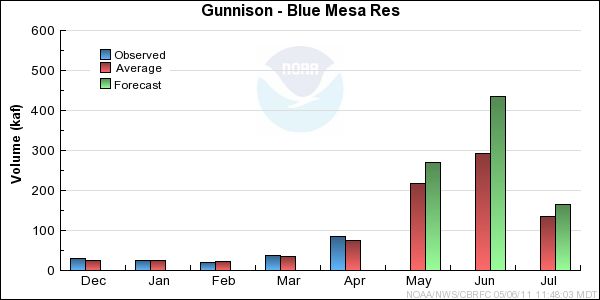
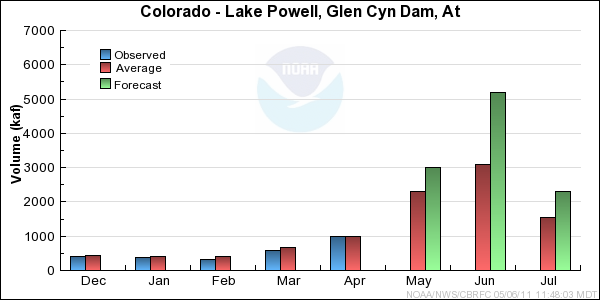
Monthly Streamflows
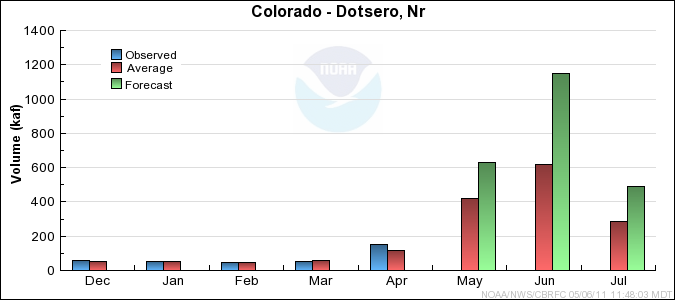
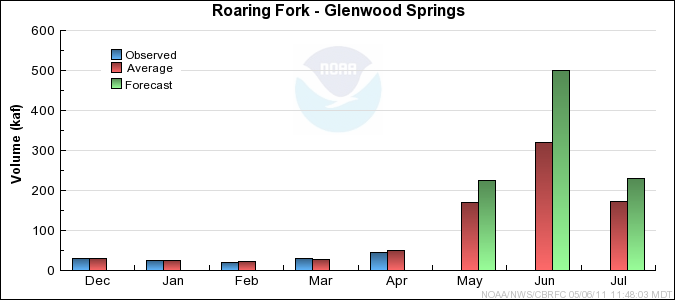
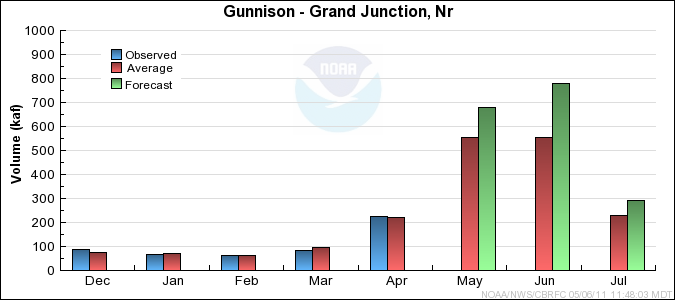
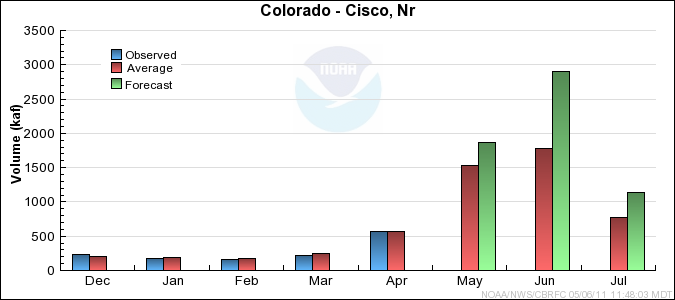
Precipitation Maps
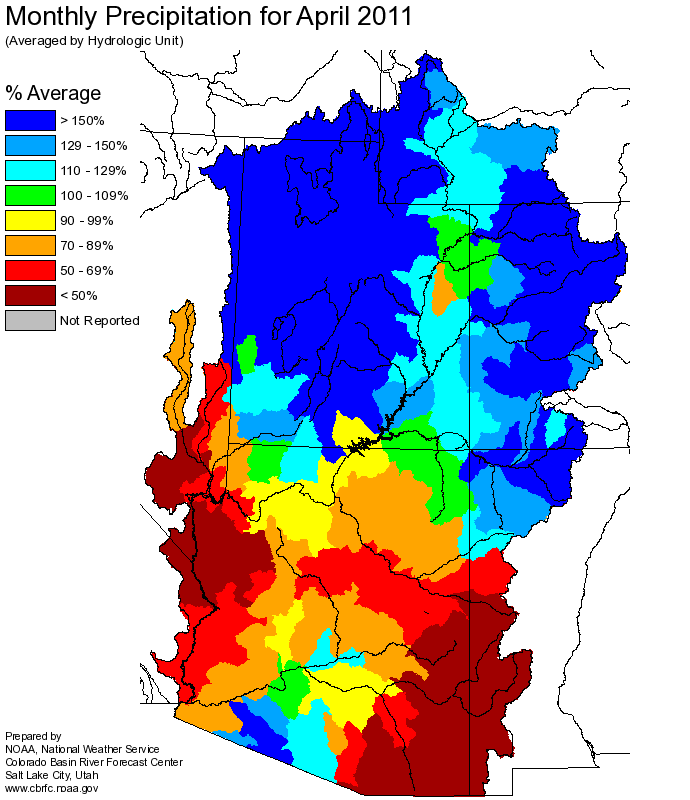
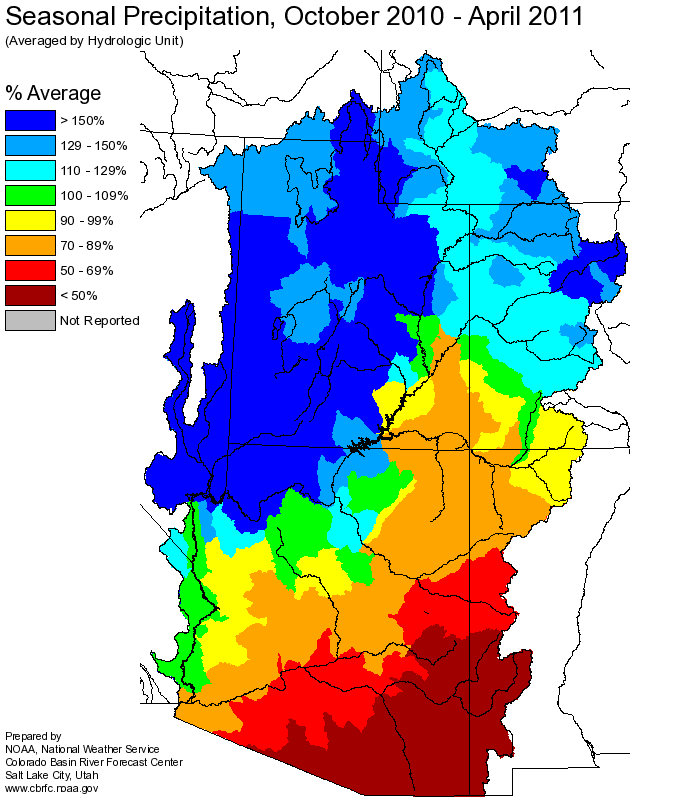
Hydrologist: Brenda Alcorn, Tracy Cox













